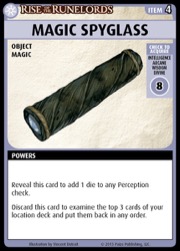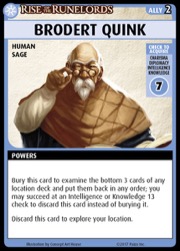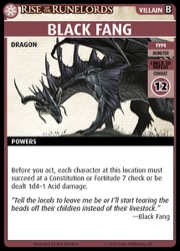| Doppelschwert |
Sorry for the off-topic question, but why has the Brodert Quink card gotten a facelift and is listed with a copyright at 2017, while the other cards seem to be the original versions of the original release with a 2013 copyright?
Having seen the original card so many times, this strikes me as very odd, especially since it's missing the 'POWERS' bar above its text.
| Frencois |
If you're not ready to win the game, don't worry about temp closes
I would add (if I may) the following to that paragraph (from our experience that I must admit is limited to large groups):
Corollary #2: This said, adding blessings to locations, even if you won the fight against the villain is a mixed blessing (pun intended).
If you have many "divine" characters in your gtoup, they will easily (even automaticaly) win those when encountering those new blessings, replay them to rexeplore (thus not losing anytime), cure themselves at some point (most "divine" can somehow do), and then get another blessing in their deck to help others or reexplore. Bottom line, usually in fact a "blessing" (even if you didn't defeat the villain).
If you have 0 or so "divine" characters in your group, and the larger your group is, the more chances that the guy encountering the blessing won't be able to acquire it. You just lost an exploration. And in a large group, time is of the essence. Bottom line, usually in fact a "curse" (even if you defeated the villain).
So if you have no chances to immediately win when encountering the villain, you may decide to throw more or less resources to temp close depending on how many characters have "divine" as a skill.
Corollary #3: never forget that, even if you know the villain will escape, there are some locations you may want to try to close. It could be obvious ones (close condition is aquire a random boon from the box), or less obvious ones (close condition is banish some cards that you have in hand, that pollutes you deck, and that you cannot otherwise banish; or close condition is recharge your hand while you actually want that).
| Frencois |
Be prepared to beat the villain
Corollary #2: Remember that defeating the villain closes the location (that's winning time especially if there are still a lot of cards) and that by cleverly temp closing specific locations you can "drive" the villain to a location you would have a hard time to close (or that you do not want to visit early in the game because of bad things happening there).
So, even if you can escape, even if the cost of undefeating would be low (few locations to escape to and/or a villain only doing combat damage when you have no cards left in hand for example), even if you have time on the clock, in certain cases it may be worthwhile throwing all you have against the villain.
Note that the rules remain silent on whether you should read the villain card before playing the scenario
Don't!
Why spoil the fun?The good thing now that I have 200 villains is that I do not remeber what they do.
That's VERY good for replays.
We never read cards that we shuffle in locations. Only scenarios.
We read the scenario AFTER we have rebuild our decks and drawn our first hand.
 JohnF
JohnF
|
| 1 person marked this as a favorite. |
Another nice blog also wrote:Note that the rules remain silent on whether you should read the villain card before playing the scenarioDon't!
Why spoil the fun?
The rules are silent on this point for a very good reason - not everybody likes to play the same way.
You choose to play without knowing anything about the villain (and henchmen). That's fine. Other people might like to at least know what sort of villain they are up against (monster? human? undead?). And some folks prefer to know everything they can about their expected foes.
What you define as fun isn't necessarily the same thing others enjoy.








